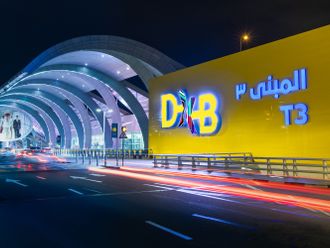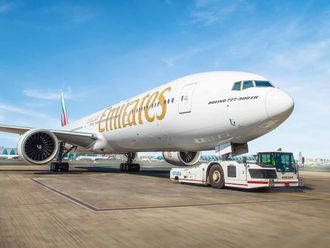Dubai: His Highness Shaikh Mohammad Bin Rashid Al Maktoum, Vice-President and Prime Minister of the UAE and Ruler of Dubai, viewed yesterday a number of architectural designs prepared for the Al Maktoum International Airport Project, which will be the largest airport in the world when completed.
Shaikh Mohammad viewed the maps and architectural models for the project and was accompanied by Shaikh Hamdan Bin Mohammad Bin Rashid Al Maktoum, Crown Prince of Dubai; Shaikh Maktoum Bin Mohammad Bin Rashid Al Maktoum, Deputy Ruler of Dubai; and Shaikh Ahmad Bin Saeed Al Maktoum, President of Dubai Civil Aviation and Chairman and CEO of Emirates airline and Group.
Shaikh Ahmad said that the project will be carried out in two phases, covering an area of 65 square kilometres in Jebel Ali and 40 kilometres away from the centre of Dubai. The first stage could cost up to Dh120 billion.
Shaikh Mohammad also stopped at the architectural design of “the light box-the jewel design” and expressed his admiration for the idea and simplicity of the idea and ordered its implementation for the Al Maktoum International Airport, a prominent culturally distinctive landmark. Shaikh Mohammad said that the giant project is economic and contributes significantly to the promotion of the industry sector of air transport, shipping and investment, and reflects the county’s interest in strengthening its status in general and that of Dubai in particular on the map of the aviation industry, which has become a major industry in the world.
Shaikh Ahmad added that the latest technical innovations were adopted with the possibility of updating in the future, which focuses on sustainability and a commitment to the application of environmental standards, such as renewable energy generation and the use of “mechanisms directed automatically” and installing panels to generate electricity from solar energy and recycling of solid waste and water treatment.
One of the areas that will be the adoption of modern technologies the adoption of biometrics and tracking system for smart travellers
Shaikh Ahmad also explained the main characteristics of the airport building and of five parallel runways for aircraft classified as type “F”. Each runway, he said, will be 4.5 kilometres long and spaced apart to allow the use of four runways for landing and takeoff of aircraft at the same time.
He also said that there will be a triple network tract classified “F” along the sides of the two runways along the passenger stations buildings, located in the centre of the airport, in addition to the triple network intersecting with the previous network across the buildings area to secure movement of aircraft within a short time.
He added that there will be two main buildings, one for arrivals and the other for departures, in addition to the four “Concourse” buildings, each 2.8 kilometres long with three central points. All stations will be seven times the size of a football field.
Each station, he added, will have 100 parking spaces for wide bodied airplanes and will hold 65 million passengers. Thus the total capacity of the airport will hold 220 million passengers with 400 airplane parking spaces











